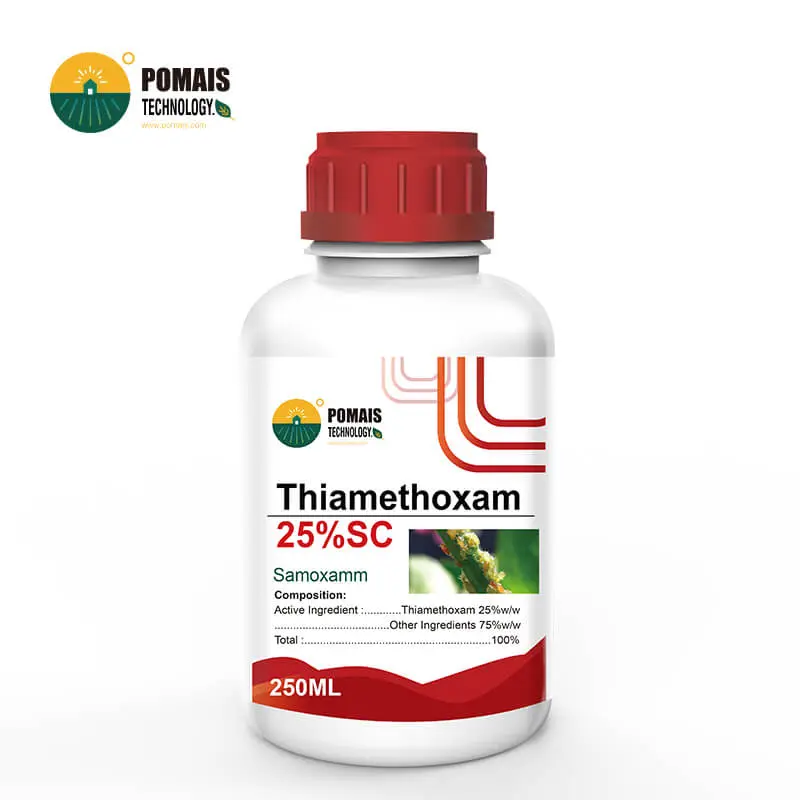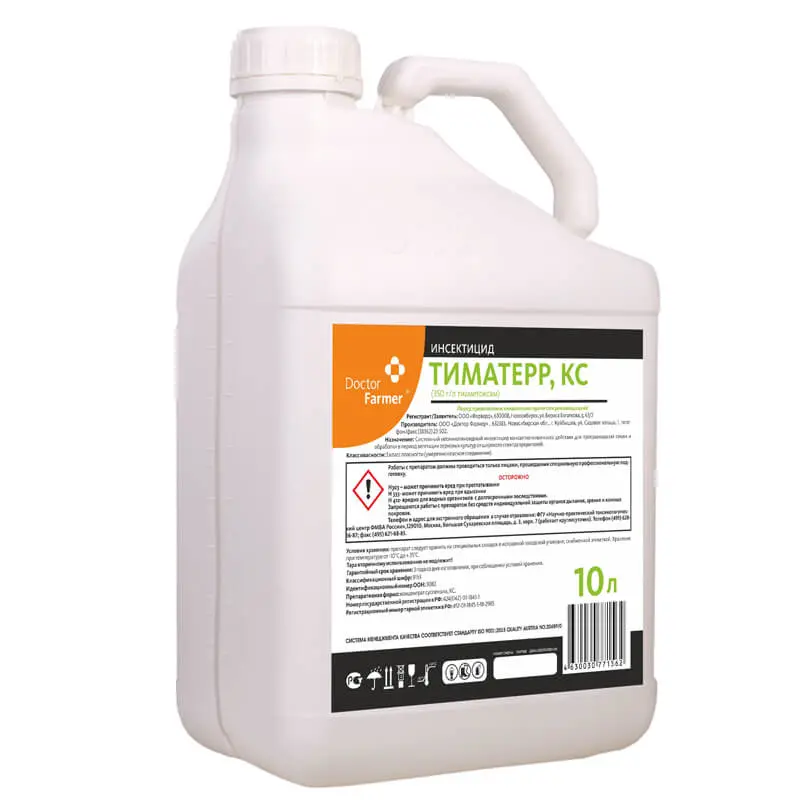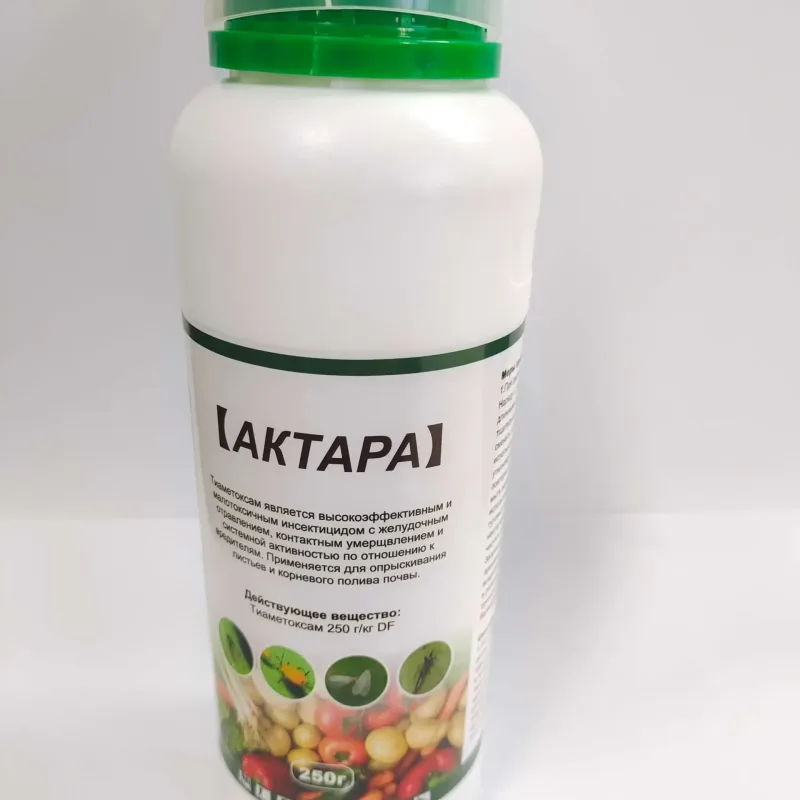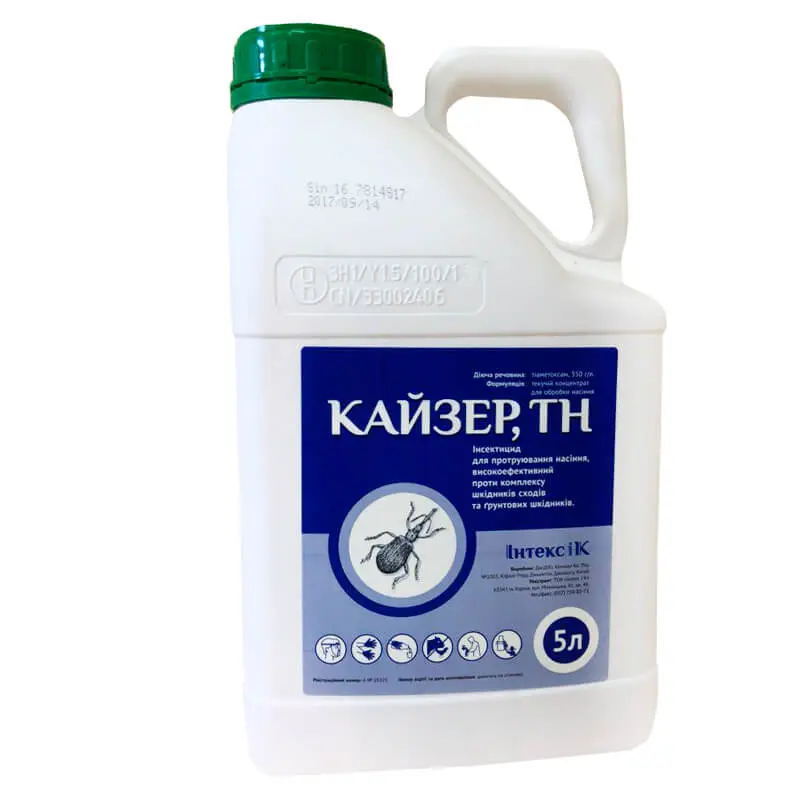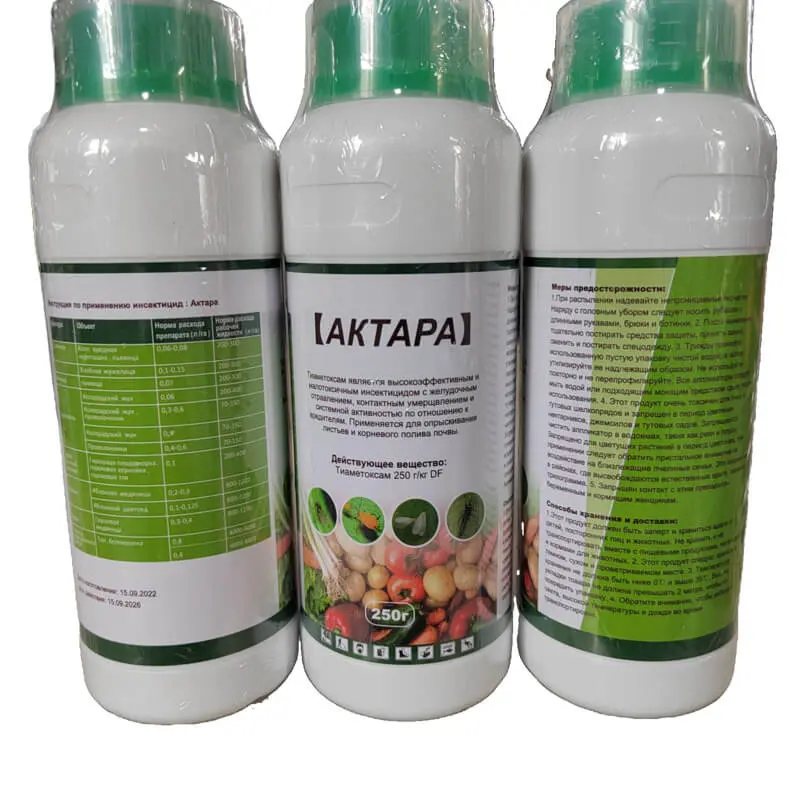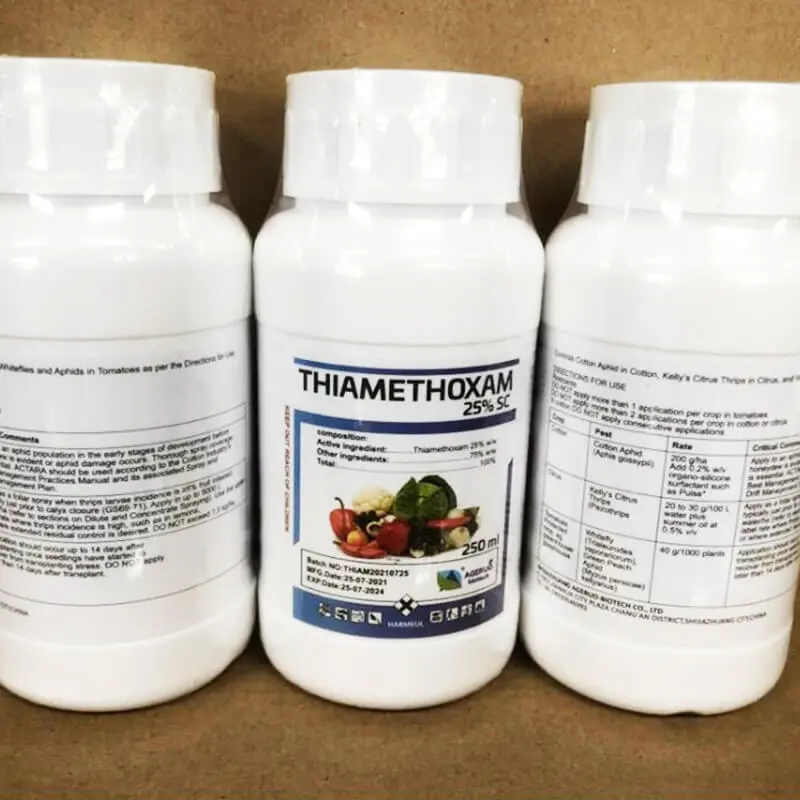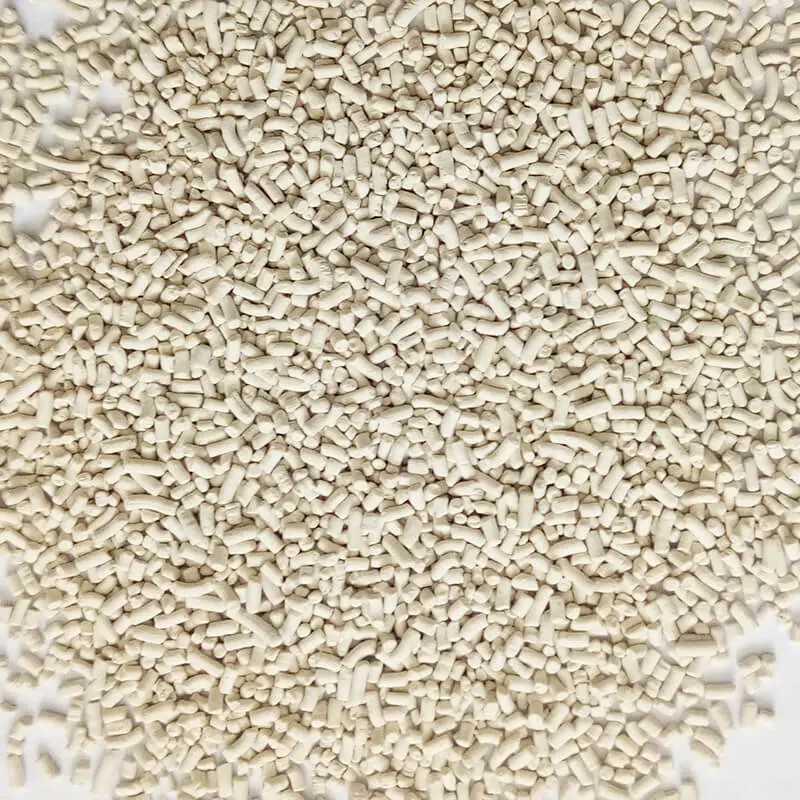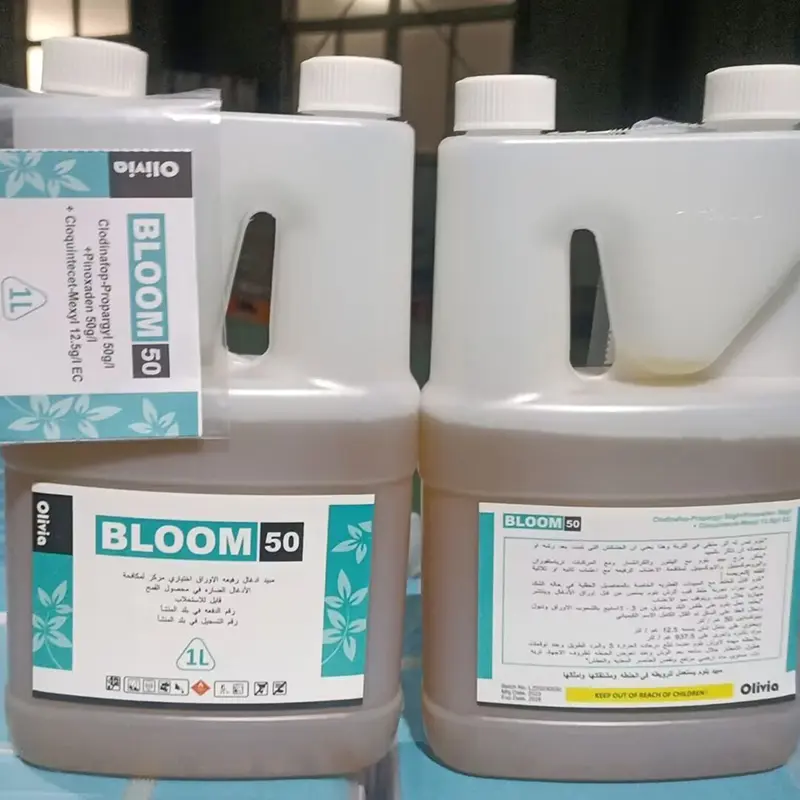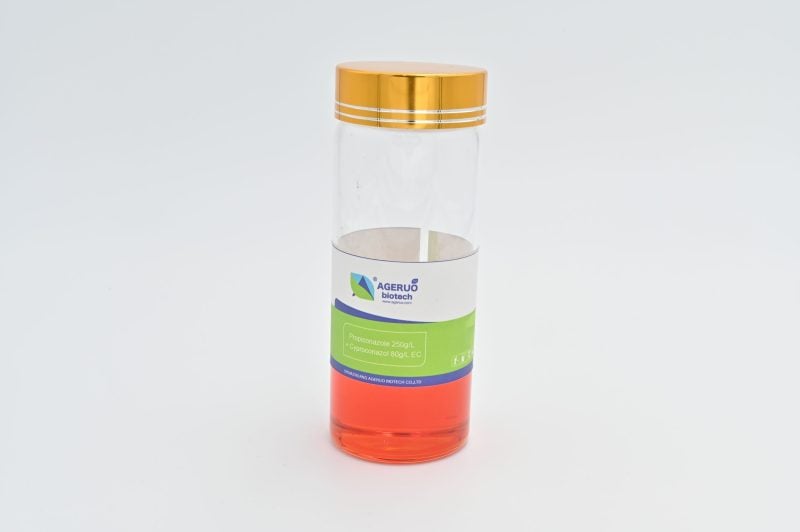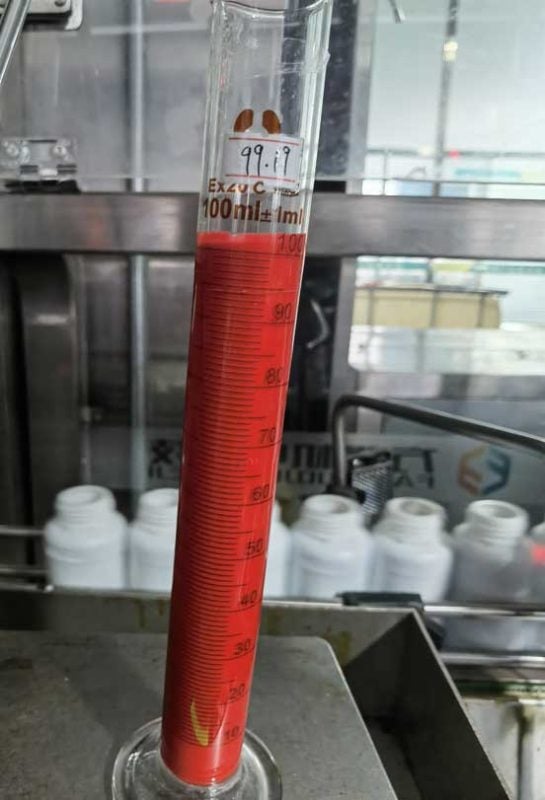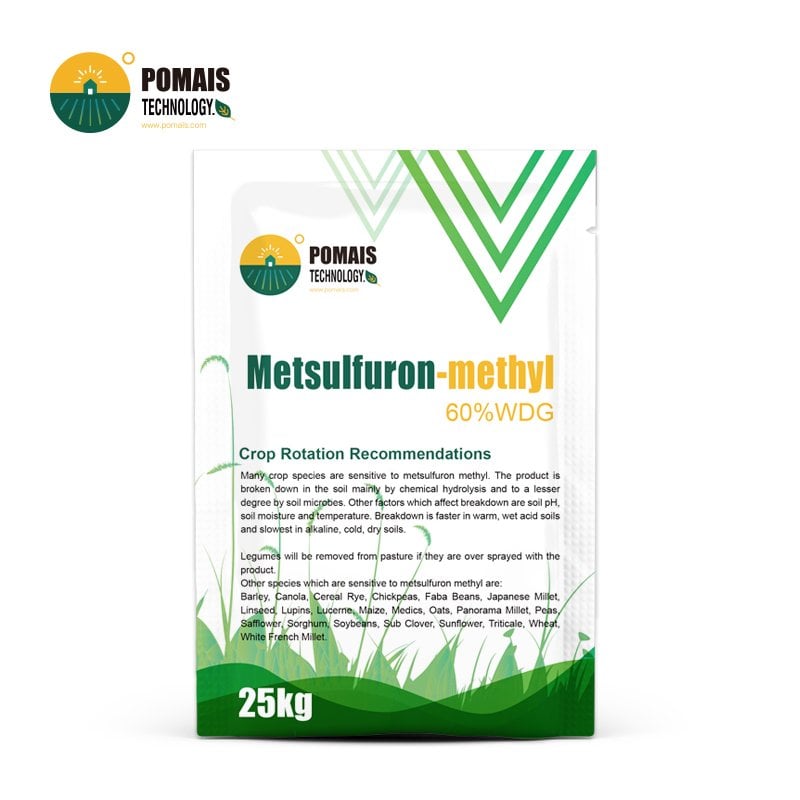Thiamethoxam Insecticide 25%WDG
Fast-Acting Systemic Insecticide for Modern Farming
Looking for a powerful, broad-spectrum insecticide that works inside and out? Thiamethoxam 25% WDG offers rapid systemic and contact action against aphids, thrips, whiteflies, rice hoppers, and more. Ideal for seed treatment and foliar application across crops like rice, cotton, corn, and vegetables, it boosts plant health while minimizing pest pressure.
Quick absorption
Full-plant protection
Versatile use (foliar & seed)
OEM & private label support available
Available in bulk for importers and distributors worldwide. Get a quote today and scale your agro business with a trusted formulation.
- Designed for Professional Buyers & Bulk Orders
- This product is available for business purchase and large-scale distribution.
- We support custom packaging, labeling, and formulation to meet your market needs.
- Let’s build your brand together.

About Thiamethoxam Insecticide 25%WDG
About Thiamethoxam Insecticide 25%WDG
| Product Name | Thiamethoxam 25% WDG |
| Chemical Name | (EZ)-3-(2-chloro-1,3-thiazol-5-ylmethyl)-5-methyl-1,3,5-oxadiazinan-4-ylidene(nitro)amine |
| CAS Number | 153719-23-4 |
| Chemical Formula | C8H10ClN5O3S |
| Mode of Action | Neonicotinoid; targets nicotinic acetylcholine receptors causing nervous system disruption |
| Formulation Type | 25% WDG (Water Dispersible Granule) |
| Additional Formulations | 30% SC, 75% WDG, 350 g/L FS |
| Target Pests | Aphids, thrips, whiteflies, rice hoppers, flea beetles, and other sucking/chewing insects |
| Recommended Crops | Rice, corn, cotton, vegetables, potatoes, fruit trees |
| Application Methods | Foliar spray, seed treatment |
| Rainfastness | 2–3 hours post-application |
| Shelf Life | 2 years |
| Tank Mix Compatibility | Compatible with most insecticides, fungicides, and some herbicides (jar test recommended) |
| Environmental Profile | Low toxicity to mammals, low leaching, biodegradable, IPM-compatible |
| Packaging Options | 100g, 250g, 500g, 1kg pouches; 25kg drums; 200L HDPE barrels |
| Custom Formulation Service | Yes – formulation ratio, concentration, format |
| OEM & Private Label | Yes – multilingual label, brand design, anti-counterfeit packaging |
| Regulatory Documents | COA, MSDS, TDS, SGS, ICAMA support |
| Quality Control | HPLC, GC, UV testing; ISO9001 certified production |
| Global Logistics | Door-to-door to Africa, LATAM, Middle East, CIS, SEA |
| Technical Support | Usage guidance, registration dossiers, marketing materials |
Thiamethoxam 25% WDG – Broad-Spectrum Systemic Insecticide That Works From the Inside Out
Looking for a powerful, reliable, and long-lasting insecticide that doesn’t mess around with pests? Say hello to Thiamethoxam 25% WDG, your go-to neonicotinoid warrior designed for serious pest control—especially against aphids, thrips, whiteflies, and rice hoppers.
This water-dispersible granule formulation dissolves easily, spreads evenly, and works systemically—meaning it’s absorbed into the plant and circulated throughout, from roots to leaves to pollen. You spray it, your crops soak it in, and the pests? They don’t stand a chance.
Perfect For:
- Rice, cotton, corn, vegetables, and fruit trees
- Fields battling sucking and chewing insects
- Farmers who prefer less reapplication and more peace of mind
Key Features:
- Systemic insecticide with fast and lasting protection
- Suitable for foliar spray and seed treatment
- Effective against sucking pests (aphids, thrips) and chewing pests (flea beetles, hoppers)
- Helps crops tolerate stress from drought and salinity
Whether you’re farming tomatoes in Tunisia or rice in Vietnam, Thiamethoxam 25% WDG is field-tested and globally trusted. It’s easy to use, rainfast, residue-efficient, and plays nice with your existing crop protection program.
At POMAIS, we don’t just sell agrochemicals—we deliver OEM-ready, globally compliant, distribution-friendly solutions to help you grow more and stress less.
Key Product Benefits of Thiamethoxam 25% WDG
Thiamethoxam isn’t just another insecticide on the shelf—it’s your crop’s secret weapon against persistent pests. Designed for both performance and protection, it brings together speed, versatility, and crop safety in one powerful formulation.
1. Rapid Uptake and Systemic Protection
Thiamethoxam is absorbed swiftly through leaves and roots, traveling through the xylem to protect the entire plant—yes, even the parts you didn’t know needed protection. This ensures pests can’t hide, whether they bite from the top, bottom, or middle.
2. Strong Against Pests, Gentle on Crops
Its selective action targets insects’ nicotinic acetylcholine receptors, which are conveniently absent in mammals. This means it’s lethal to aphids and thrips, but won’t stress your crops or your conscience.
3. Resilient Against Weather Surprises
Rain? No problem. Thiamethoxam holds its ground. Thanks to its high rainfastness and stability, you don’t have to reapply every time the sky throws a tantrum. It stays effective even after moderate rainfall, reducing your labor and costs.
4. Broad-Spectrum Efficacy
Whether you’re battling chewing pests like flea beetles or sucking pests like whiteflies, Thiamethoxam has your back. It works across cereals, vegetables, fruits, and even ornamentals—think of it as a universal translator for pest control.
5. Enhances Plant Vigor
Stronger crops, better yields. By reducing insect feeding and disease vectoring, Thiamethoxam helps your plants redirect energy toward growth rather than survival. The result? Healthier leaves, more uniform fruiting, and fewer farmer headaches.
6. Fits Seamlessly into IPM Programs
With low toxicity to beneficials when applied correctly, Thiamethoxam integrates easily into integrated pest management strategies. It pairs well with other actives and helps delay resistance, keeping your pest control program sustainable.
Why Choose POMAIS as Your Thiamethoxam Supplier?
In a crowded agrochemical market, it’s not just about the molecule—it’s about the partner behind it. Here’s why top distributors, importers, and agribusiness buyers across five continents trust POMAIS for Thiamethoxam and beyond.
Full-Spectrum Manufacturing Capability
We’re not a trader. We’re the factory.
With ISO 9001-certified production lines, in-house R&D labs, and over 40 stable formulations, we manufacture Thiamethoxam in multiple concentrations and forms: 25% WDG, 75% WDG, 30% SC, 350 g/L FS, and more.
Need a custom blend or new formulation for a niche market? Our chemists are one call away.
Tailored OEM & Private Label Services
From your logo to your language, we adapt it all.
We support:
- Custom bottle and sachet sizes (from 10g to 200L)
- Multilingual labels (Arabic, Spanish, French, Russian, etc.)
- Compliant documentation (TDS, MSDS, COA, SGS test report, ICAMA registration file)
Whether you’re launching your own agro brand or supplying tenders, we help you go to market like a pro.
Strict Quality Control, Batch After Batch
Every raw material is tested before production. Every finished batch is triple-checked before delivery.
We use HPLC, GC, and UV spectrophotometry to ensure your Thiamethoxam meets international standards—whether you’re targeting Brazil, Nigeria, or Vietnam. No guesswork, no surprises.
Fast Delivery, Global Logistics
Our supply chain is built for international trade:
- Door-to-door delivery options across Africa, Middle East, Russia, LATAM
- Flexible incoterms (FOB, CIF, DDP available)
- Port advantage: Close to Tianjin & Qingdao with container consolidation support
In short: we know how to move goods fast and safely—even if the border paperwork gets complicated.
End-to-End Technical & Commercial Support
You’re not just buying a product—you’re getting a team.
We offer:
- Field usage guidance and IPM rotation planning
- Registration dossier support
- Marketing content co-development (leaflets, videos, social media copy)
We speak the language of farmers and regulators. That’s how we help you win market share.
Mode of Action – How Thiamethoxam Strikes Where It Hurts
Thiamethoxam doesn’t waste time negotiating—it heads straight for the insect’s nervous system. As a neonicotinoid insecticide, it mimics the neurotransmitter acetylcholine, binding to nicotinic acetylcholine receptors (nAChRs) in insects. But unlike the natural compound, it doesn’t break down. The result? A nerve overload that leads to paralysis and ultimately death.
This action works both through contact and ingestion, making Thiamethoxam a double threat—whether the insect takes a bite or just touches a treated surface, the outcome is the same: fast and irreversible damage.
Key Advantages of the Mode of Action:
- Systemic Penetration: It moves through the plant’s vascular system, reaching even hidden pests.
- Fast Knockdown: Insects exhibit symptoms within hours, with mortality typically occurring in 24–48 hours.
- Selective Targeting: Highly specific to insect nAChRs, making it safe for mammals and ideal for IPM (Integrated Pest Management) systems.
- Resistance Management: When rotated properly, it supports effective resistance management by offering a unique MoA compared to older insecticides.
In short, if pests could read this, they’d be worried.
Target Crops & Pest Spectrum
Thiamethoxam isn’t a one-trick pony—it’s your go-to insecticide for a wide variety of crops and stubborn pests. Whether you’re growing rice in humid paddies or tomatoes under greenhouse glass, this neonicotinoid is ready to defend your yield.
1. Cereal Crops
- Crops Protected: Wheat, Rice, Corn
- Target Pests: Aphids, Rice Thrips, Rice Leaf Folder, Brown Planthopper, Corn Borer
- Formulations Used: 25% WG, 350 g/L FS, 30% SC
- Why It Works: Rapid systemic movement shields young shoots and leaves from sap-feeding and chewing pests.
2. Cotton
- Target Pests: Cotton Aphids, Bollworms, Thrips
- Formulations: 25% WG, 30% SC
- Result: Keeps cotton buds clean and bollworm-free, improving lint quality and yield.
3. Vegetables (Open Field & Greenhouse)
- Key Crops: Tomato, Cucumber, Chili, Eggplant
- Common Pests: Whiteflies, Thrips, Aphids, Leafhoppers
- Formulations: 75% WDG, 25% SC
- Grower’s Advantage: Helps reduce virus vector insects like whiteflies, protecting against indirect damage.
4. Fruit Crops
- Major Crops: Citrus, Grapes, Apple
- Pests Controlled: Citrus Psyllid, Fruit Flies, Aphids
- Usage Form: 25% WG, 30% SC
- Benefit: Cleaner fruit with better shelf-life and market appeal.
5. Legumes & Oilseeds
- Examples: Soybean, Rapeseed
- Target Pests: Leafhoppers, Aphids, Pod borers
- Impact: Reduced pest stress means stronger vegetative growth and higher pod formation.
6. Specialty Crops
- Use Cases: Tea, Tobacco, Ornamental Plants
- Pests: Tea Thrips, Tobacco Budworm, Greenhouse Whiteflies
- Formulations: 25% SC, 75% WDG
- Note: Especially effective in controlled environments where persistent residues are undesirable.
Versatile + Effective: From seed to harvest, Thiamethoxam offers cross-crop protection against the most economically damaging insects—giving you peace of mind and better profits.
Application Methods & Recommended Dosage
Using Thiamethoxam isn’t rocket science—but a little precision goes a long way. Whether you’re spraying rows of tomatoes or treating tons of rice seed, here’s how to apply it right for maximum effect.
1. Foliar Spray
Ideal for fast-acting control of active pest outbreaks. Thiamethoxam’s systemic movement ensures the entire plant is protected—even the parts you can’t reach with a nozzle.
- Common Formulations: 25% WG, 30% SC, 75% WDG
- Recommended Dosage (per hectare):
- Wheat (Aphids): 8–10 g (25% WG)
- Tomato (Thrips): 200–286 ml (25% SC)
- Cucumber (Aphids): 5–6 g (75% WDG)
Pro tip: Apply in early morning or late afternoon for better absorption and less evaporation.
2. Seed Treatment
Your first line of defense—before the pests even get started. Thiamethoxam-treated seeds give crops a strong, pest-resistant start and improve early vigor.
- Common Formulation: 350 g/L FS
- Recommended Dosage:
- Rice / Corn: 200–400 g per 100 kg of seed
Uniform coating and proper drying are crucial—don’t rush it!
3. Irrigation and Soil Drench (in special cases)
While not the most common method, soil drench or fertigation can be used in high-value crops like greenhouse vegetables. It ensures root uptake and long-lasting internal protection.
- Always follow local agronomic guidance and label instructions when using this method.
Usage Guidelines
- Water Volume: 300–500 L/ha for foliar sprays (adjust based on canopy size).
- Spray Timing: Early pest emergence or at threshold levels, depending on crop scouting.
- Mixing Compatibility: Compatible with most insecticides and fungicides—but jar test first!
Usage Methods & Recommended Dosage
When it comes to using Thiamethoxam, precision is your best friend. Its versatility allows for both foliar application and seed treatment, making it adaptable to different crop management systems. Here’s how you can apply it for maximum pest control without overuse or waste.
Foliar Spray Application
Ideal for rapid knockdown of above-ground pests like aphids, thrips, and whiteflies. Ensure uniform coverage for best results, especially on the underside of leaves where pests often hide.
| Formulation | Target Crop | Target Pest | Recommended Dose | Application Timing |
|---|---|---|---|---|
| 25% WG | Wheat | Aphids | 8–10 g/ha | At early infestation |
| 25% SC | Tomato | Thrips | 200–286 ml/ha | Pre-flowering stage |
| 75% WDG | Cucumber | Aphids | 5–6 g/ha | Vegetative stage |
Seed Treatment
For early-stage protection, especially in rice and corn, seed coating with Thiamethoxam ensures systemic uptake and shields young plants from soil pests and early foliar feeders.
| Formulation | Target Crop | Target Pest | Recommended Dose | Notes |
|---|---|---|---|---|
| 350 g/L FS | Rice | Thrips, Leafhoppers | 200–400 g/100 kg of seed | Use high-quality treated seed |
| 350 g/L FS | Corn | Wireworms, Corn Rootworm | 300–500 g/100 kg of seed | Ensure even coating |
Best Practice Tips
- Use sufficient water volume to achieve thorough coverage in foliar sprays (e.g., 200–500 L/ha depending on crop density).
- Avoid applications during high wind or extreme sunlight to prevent drift or degradation.
- Always follow local pesticide use regulations and observe pre-harvest intervals.
Mixed Formulation Options – Power Duos for Enhanced Pest Control
Sometimes, one molecule just isn’t enough. That’s where Thiamethoxam shows its real versatility—by teaming up with other actives to deliver broader pest control, stronger knockdown, and smarter resistance management. These blended formulations are tailor-made for high-pressure pest zones and multi-pest cropping systems.
1. Thiamethoxam + Lambda-Cyhalothrin (SC/WDG)
What it does:
Combines the systemic power of Thiamethoxam with the fast-acting, contact kill of Lambda-Cyhalothrin—a pyrethroid powerhouse. While Thiamethoxam travels through plant tissues, Lambda works on the surface to zap pests before they can blink.
Pests controlled:
- Sucking pests: Aphids, thrips, whiteflies, jassids
- Chewing pests: Leaf folders, bollworms, stem borers
Crops:
Cotton, rice, maize, soybeans, vegetables
Top markets:
- India: Popular in cotton and paddy rotations
- Nigeria: Used in large-scale vegetable and maize programs
- Southeast Asia: Strong adoption for rice pest management
Why it works:
Immediate knockdown + systemic residual = less reapplication, better field results.
2. Thiamethoxam + Chlorantraniliprole (ZC)
What it does:
This duo brings together a neonicotinoid (Thiamethoxam) and a diamide (Chlorantraniliprole) for dual-action control. Think of it as internal nervous system shutdown plus muscle paralysis—together, they hit pests hard and fast.
Pests controlled:
- Lepidopteran larvae: Rice stem borers, cotton bollworms
- Sucking pests: Whiteflies, thrips, leafhoppers
Crops:
Rice, cotton, chili, tomato, corn
Top markets:
- Brazil: Widely used in soybean and corn
- Egypt: Approved for vegetable and fruit crop IPM
- Vietnam: Trusted in rice-intensive regions for borer control
Why it works:
Broader mode-of-action spectrum lowers resistance risks and ensures all pest life stages are covered—from egg to adult.
3. Thiamethoxam + Acetamiprid (WDG/EC)
What it does:
Both are neonicotinoids, but with slightly different binding behaviors. Together, they enhance receptor coverage and deliver faster pest suppression—ideal when you need a strong systemic punch.
Pests controlled:
Aphids, whiteflies, planthoppers, mealybugs
Crops:
Citrus, grapes, tea, tobacco, sugarcane
Top markets:
- China & Russia: For greenhouse and orchard pest programs
- Middle East: In citrus and vineyard applications
Why it works:
Improved systemic load in plants = longer protection and stronger coverage.
4. Custom OEM Mixes at POMAIS
Need something specific for your region or resistance problem?
We can create custom blends combining Thiamethoxam with:
- Pyrethroids
- Diamides
- Insect growth regulators (IGRs)
- Fungicides for combo crop protection
With flexible formulation formats (SC, WDG, FS, ZC), multilingual labels, and full compliance support, we’re ready to tailor the right mix for your market.
Tank Mix Compatibility & IPM Role
Thiamethoxam doesn’t believe in working alone—and neither should you. In the ever-evolving battle against pest resistance, flexibility and synergy are your best allies. That’s why this insecticide is highly compatible with other agrochemicals, making it a powerful tool in both tank mix strategies and Integrated Pest Management (IPM) programs.
Excellent Tank Mix Compatibility
Thiamethoxam shows strong physical and chemical stability when mixed with:
- Fungicides (e.g., azoxystrobin, mancozeb) – for simultaneous control of pests and diseases
- Herbicides (check pH and formulation compatibility)
- Other insecticides (such as lambda-cyhalothrin or chlorantraniliprole) – for enhanced spectrum and resistance management
Pro tip: Always conduct a jar test before large-scale mixing. Some emulsifiable concentrates (ECs) may cause incompatibility in hard water or extreme pH conditions.
Strategic Role in IPM Programs
As a neonicotinoid with systemic activity and long residual control, Thiamethoxam plays a strategic role in reducing pest pressure early in the season and minimizing the need for repeated applications.
Benefits in an IPM context:
- Targeted control of sucking pests like aphids and whiteflies without harming beneficial insects when used as directed
- Lower resistance risk when rotated or combined with other MoAs (Modes of Action)
- Seed treatment protection that reduces the need for early foliar sprays, promoting more efficient scouting and threshold-based interventions
In short, Thiamethoxam gives you chemical flexibility, operational convenience, and resistance mitigation—all wrapped up in one formulation.
Rainfastness & Environmental Behavior
Thiamethoxam isn’t just effective—it’s weather-resistant and environmentally conscious. Whether you’re spraying under a cloud or under pressure, this insecticide has been built to perform under real-world field conditions.
Rainfastness: Keeps Working After the Rain
One of the standout features of Thiamethoxam is its excellent rainfastness. Within just a few hours of application, the product is absorbed by plant tissues and starts moving systemically, making it resistant to wash-off from rain or overhead irrigation. In fact:
- Rainfastness time: Typically within 2–3 hours after foliar application
- Systemic movement: Ensures pest protection even on unsprayed parts
So, even if the weather forecast isn’t on your side, your pest control program still is.
Stability in Soil and Water
Thiamethoxam offers a balanced environmental profile:
- Moderate soil persistence: Long enough to provide residual control, short enough to avoid buildup
- Low leaching potential: Minimizes movement into groundwater under proper usage
- Photostability: Good resistance to sunlight degradation means it won’t vanish before it acts
This makes it suitable for diverse farming environments—from sunny vineyards to flooded rice paddies.
Eco-Conscious Pest Control
Though powerful against pests, Thiamethoxam maintains a low environmental footprint:
- Breaks down into non-toxic metabolites, reducing long-term environmental residue
- Minimal impact on non-target organisms when used as directed
- Bee safety: Lower-risk when applied outside foraging hours or via seed treatment
In short, it’s tough on pests but plays fair with nature.
Regulatory & Safety Profile
You’re not just looking for an effective insecticide—you’re looking for one that checks every regulatory box and won’t give your compliance team a headache. That’s where Thiamethoxam shines. Backed by extensive toxicological testing and international certifications, it’s built for safe, legal, and responsible pest control in global markets.
Toxicological Safety
Let’s talk numbers. Thiamethoxam is recognized for its low toxicity profile in mammals and its selective action on insect nervous systems:
- Oral LD₅₀ (rat): >500 mg/kg – categorized as low acute toxicity
- Dermal LD₅₀ (rat): >2000 mg/kg – non-irritant classification
- Inhalation LC₅₀: >1.39 mg/L – minimal inhalation risk under normal handling
- Skin & Eye Irritation: Not classified as an irritant under EU guidelines
In short: Safe for trained applicators when used as directed, and friendly to the kind of safety audits your buyers actually care about.
Environmental Compliance
Thiamethoxam complies with environmental guidelines across multiple regions:
- EU REACH Compliant
- Registered under ICAMA (China)
- EPA-approved uses in the United States
- Residue levels within MRLs (Maximum Residue Limits) for major export crops
Its rapid biodegradation in soil and low leaching potential make it suitable for IPM programs and long-term sustainability strategies.
Global Registration & Market Acceptance
POMAIS’s Thiamethoxam formulations have been successfully registered and sold in key agrochemical markets:
- Middle East: Widely used for high-value horticultural crops under harsh climate conditions
- South America: Certified for soybean, corn, and cotton programs
- Africa: Trusted by commercial farms for systemic pest protection
- Russia & CIS countries: Registered for cereals and potatoes under local pesticide laws
Need support with your own registration? We provide technical dossiers, COAs, MSDS, and full regulatory documentation to help speed up your product approvals.
Storage & Handling Guidelines
Let’s face it—pesticide performance starts well before the sprayer hits the field. How you store and handle Thiamethoxam can make a significant difference in product stability, operator safety, and overall application effectiveness.
Storage Best Practices
To preserve the potency and shelf life of your Thiamethoxam insecticide, follow these storage recommendations:
- Temperature: Keep the product in a cool, dry, and well-ventilated area. Ideal temperature: 5–35°C (41–95°F).
- Sunlight: Avoid direct exposure to sunlight or heat sources. Prolonged heat can degrade the active ingredient.
- Moisture Control: Store in original, tightly sealed containers to prevent clumping or loss of dispersibility, especially for WDG or FS formulations.
- Segregation: Keep separate from food, feed, and potable water supplies. Also avoid contact with strong acids or alkalis.
Safe Handling Guidelines
Your safety matters. Whether you’re preparing seed treatments or spraying foliar applications, here’s how to stay protected:
- Wear protective gear: Gloves, goggles, long sleeves, and a mask when handling the product.
- Use calibrated equipment to avoid under- or over-dosing.
- Avoid inhalation or skin contact: Although Thiamethoxam has low mammalian toxicity, it’s best to avoid unnecessary exposure.
- Wash hands and tools thoroughly after application and before meals or smoking.
- Spillage protocol: Contain and absorb with sand or inert material. Do not wash into drains or water bodies.
Shelf Life
Under proper storage conditions, Thiamethoxam has a shelf life of 2 years, maintaining its physical integrity and efficacy. Always refer to the batch label and avoid using expired product, even if it looks fine—because efficacy isn’t always visible.
Packaging & OEM Services
Looking to bring Thiamethoxam to your local market with your own brand identity? You’re in the right place. At POMAIS, we don’t just sell active ingredients—we build product solutions tailored to your distribution needs.
Flexible Packaging Options
Whether you’re supplying large-scale farms or retail outlets, we offer packaging that fits:
- Bulk industrial options: 25kg fiber drums or 200L HDPE barrels for large-scale mixing operations
- Commercial-ready formats: 100g, 250g, 500g bottles or pouches for easy handling and resale
- Seed treatment packaging: Special moisture-proof containers designed for FS formulations
All packaging materials comply with international shipping standards and are designed for durability, safety, and efficient logistics.
Custom Labeling & Branding
We understand that your brand matters—and we’re here to help you grow it. Our OEM services include:
- Private label design based on your market language and regulatory needs
- Multilingual labels and documentation, including SDS, MSDS, COA, and product leaflets
- Compliance-ready packaging, tailored to target market registration and retail requirements
Want a modern, retail-friendly look? Or a minimalist design for industrial sales? We’ve got an in-house design team that gets it right the first time.
Low MOQ, Global Supply
Whether you’re a startup distributor or an established agrochemical brand, we support:
- Low minimum order quantities (MOQ) to reduce entry barriers
- Global fulfillment logistics through sea, air, and rail cargo routes
- Pre-shipment inspection & quality control with full traceability
From formulation to final shipment, we ensure your product arrives market-ready—clean, compliant, and compelling.
Public Health & Non-Agricultural Use – Beyond the Farm Gate
Thiamethoxam may be known for its role in crop protection—but its usefulness doesn’t stop at the edge of the field. With its potent action against sap-sucking insects and favorable mammalian safety profile, Thiamethoxam is also being explored in a variety of urban, horticultural, and public health settings, especially where long-lasting systemic protection is essential.
1. Ornamental & Landscape Plants
Where it works:
- City landscaping (boulevards, green belts, public parks)
- Golf courses, botanical gardens, and hotel landscapes
- Residential lawn & garden nurseries
Pest problems it solves:
Whiteflies, aphids, mealybugs, thrips—pests that damage leaves, flowers, and ornamental value.
Why it’s preferred:
- Systemic movement ensures long-term pest control
- Rainfastness supports application in sprinkler-irrigated areas
- No visible residue on foliage—a must for aesthetic plants
2. Turf & Lawn Management
Urban turf managers and municipal contractors use Thiamethoxam-based formulations for:
- Sod farms
- Sports grounds
- Recreational turf under high pest pressure
Target pests:
Billbugs, mole crickets, chinch bugs, and turf-damaging aphids.
Why it fits:
Granular and liquid formulations can be easily incorporated into existing turf care programs with minimal disruption and strong residual control.
3. Peri-Urban & Perimeter Pest Control
In semi-rural or peri-urban zones, Thiamethoxam may be deployed in non-edible hedges or windbreak plants as a perimeter defense:
- Stops insect migration into crops or greenhouses
- Protects ornamental hedges from chewing or sucking insects
- Reduces vector populations around sensitive areas
4. Potential Public Health Use (Under Regulation)
While Thiamethoxam is not primarily a vector control agent, in some countries it has been researched for off-label use against mosquito larvae and disease vectors, particularly in treated perimeters or seedbeds that may reduce vector habitats.
Important note:
Public health use is subject to strict national regulations, and Thiamethoxam is not labeled as a primary public health insecticide. Always consult local pesticide laws before using in public health contexts.
Why This Matters for Buyers:
- Opens up new sales channels beyond agricultural retail
- Provides value-added use cases for ornamental and urban landscaping clients
- Supports distributor diversification into non-food sectors
- Showcases product versatility and ROI in broader market segments
Frequently Asked Questions About Thiamethoxam Insecticide
What is Thiamethoxam?
Thiamethoxam is a systemic neonicotinoid insecticide used for controlling a wide spectrum of sucking and chewing pests. It is absorbed by plants and translocated throughout, offering protection from root to shoot.
What is Thiamethoxam Used For?
Thiamethoxam is primarily used for:
- Seed treatment in rice, corn, and wheat
- Foliar spraying in vegetables, cotton, and fruit trees
- Controlling aphids, thrips, whiteflies, and hoppers
It is valued for fast knockdown, residual control, and compatibility in IPM programs.
How Does Thiamethoxam Work? (Mode of Action)
It mimics acetylcholine and binds to nicotinic acetylcholine receptors (nAChRs) in insects, leading to nervous system failure. Its dual action—through ingestion and contact—ensures quick and fatal effects on target pests.
Can Thiamethoxam Be Used for Bed Bugs?
No. Thiamethoxam is not approved for bed bug control. It is strictly for agricultural and horticultural pest management, not for household or public health use.
What is the CAS Number of Thiamethoxam?
The CAS number for Thiamethoxam is 153719-23-4, used for regulatory identification.
What is the Chemical Formula of Thiamethoxam?
The molecular formula is C8H10ClN5O3S, with a molecular weight of 291.72 g/mol.
What is Thiamethoxam Technical?
“Thiamethoxam Technical” refers to the concentrated raw material used to manufacture formulations like 25% WDG, 75% WDG, 350g/L FS, and 30% SC. It typically contains ≥95% a.i. and must meet strict QC standards.
Thiamethoxam vs. Fipronil – What’s the Difference?
- Thiamethoxam: systemic, ideal for aphids, hoppers, thrips
- Fipronil: contact + ingestion, good for termites, soil pests
Used together in seed treatments for broad-spectrum early protection.
Thiamethoxam vs. Imidacloprid – Which Is Better?
- Thiamethoxam: Faster plant uptake, broader systemic movement
- Imidacloprid: Longer soil persistence
Both are neonicotinoids; rotation is advised to avoid resistance.
Thiamethoxam vs. Indoxacarb
- Thiamethoxam targets nAChRs – best for aphids, thrips, leafhoppers
- Indoxacarb disrupts sodium channels – ideal for caterpillars
They complement each other in IPM strategies.
What is Thiamethoxam + Chlorantraniliprole Used For?
This dual-action formulation combines:
- Thiamethoxam (for sucking pests)
- Chlorantraniliprole (for caterpillars and leafminers)
Used widely in vegetables, rice, and grapes for full-spectrum pest control.
Is There a Thiamethoxam + Fipronil Combo?
Yes, especially for seed treatment in corn and rice. Controls both soil pests and early foliar feeders.
Can Thiamethoxam Be Combined with Imidacloprid?
While technically possible, it’s not recommended due to shared MoA (Group 4A). Rotation is more effective for resistance prevention.
What About Clothianidin + Thiamethoxam?
Both are neonicotinoids. Combining them may have marginal benefit and should only be used under high pest pressure or regulatory allowance.
What’s the Advantage of Thiamethoxam + Cyantraniliprole?
Ideal for greenhouse vegetables and IPM-sensitive crops. Controls:
- Whiteflies, aphids (via Thiamethoxam)
- Lepidoptera larvae, leafminers (via Cyantraniliprole)
Why Use Thiamethoxam + Lambda-Cyhalothrin?
This is a popular tank-mix or co-formulation that offers:
- Contact + systemic control
- Sucking + chewing pest protection
- Fast knockdown + residual activity
Perfect for cotton, soybean, maize, vegetables.
Is Thiamethoxam Safe for Bees and Pollinators?
Thiamethoxam is low-risk when used responsibly. Recommendations:
- Do not apply during flowering
- Avoid spraying during bee foraging hours
- Prefer seed treatment for bee-safe control
How Long is the Residual Effect of Thiamethoxam?
Depending on dosage and crop, residual effect lasts 10–21 days for foliar spray and up to 4–6 weeks in seed treatments.
What’s the Shelf Life and Proper Storage?
Shelf life: 24 months in original packaging
Storage: Cool (5–35°C), dry, shaded place, away from food and feed. Seal tightly after use to prevent moisture absorption.
Can Thiamethoxam Be Used with Fertilizers?
Yes. Thiamethoxam is compatible with most fertilizers, but conduct a jar test first to ensure physical stability, especially in foliar tank mixes.
Partner with POMAIS — Let’s Grow Your Agrochemical Business Together
Ready to boost your crop protection lineup with high-quality Thiamethoxam formulations?
Whether you’re:
- Expanding your import portfolio with a reliable supplier,
- Launching your own branded pesticide line,
- Or looking for a registration-ready product with global compliance support,
POMAIS is your manufacturing partner of choice.
We offer:
- Stable supply across 25% WDG, 75% WDG, 30% SC, 350g/L FS, and more
- Custom packaging and multilingual labeling
- Fast lead times and documentation for ICAMA, SGS, COA, MSDS
- Technical support, global delivery, and private-label flexibility
Don’t just buy a product—build a competitive edge.
Contact our team today for a tailored quotation, sample request, or full product catalog. Let’s help you take Thiamethoxam to market—better, faster, and smarter.
| Product Name | Thiamethoxam 25% WDG |
| Chemical Name | (EZ)-3-(2-chloro-1,3-thiazol-5-ylmethyl)-5-methyl-1,3,5-oxadiazinan-4-ylidene(nitro)amine |
| CAS Number | 153719-23-4 |
| Chemical Formula | C8H10ClN5O3S |
| Mode of Action | Neonicotinoid; targets nicotinic acetylcholine receptors causing nervous system disruption |
| Formulation Type | 25% WDG (Water Dispersible Granule) |
| Additional Formulations | 30% SC, 75% WDG, 350 g/L FS |
| Target Pests | Aphids, thrips, whiteflies, rice hoppers, flea beetles, and other sucking/chewing insects |
| Recommended Crops | Rice, corn, cotton, vegetables, potatoes, fruit trees |
| Application Methods | Foliar spray, seed treatment |
| Rainfastness | 2–3 hours post-application |
| Shelf Life | 2 years |
| Tank Mix Compatibility | Compatible with most insecticides, fungicides, and some herbicides (jar test recommended) |
| Environmental Profile | Low toxicity to mammals, low leaching, biodegradable, IPM-compatible |
| Packaging Options | 100g, 250g, 500g, 1kg pouches; 25kg drums; 200L HDPE barrels |
| Custom Formulation Service | Yes – formulation ratio, concentration, format |
| OEM & Private Label | Yes – multilingual label, brand design, anti-counterfeit packaging |
| Regulatory Documents | COA, MSDS, TDS, SGS, ICAMA support |
| Quality Control | HPLC, GC, UV testing; ISO9001 certified production |
| Global Logistics | Door-to-door to Africa, LATAM, Middle East, CIS, SEA |
| Technical Support | Usage guidance, registration dossiers, marketing materials |
Thiamethoxam 25% WDG – Broad-Spectrum Systemic Insecticide That Works From the Inside Out
Looking for a powerful, reliable, and long-lasting insecticide that doesn’t mess around with pests? Say hello to Thiamethoxam 25% WDG, your go-to neonicotinoid warrior designed for serious pest control—especially against aphids, thrips, whiteflies, and rice hoppers.
This water-dispersible granule formulation dissolves easily, spreads evenly, and works systemically—meaning it’s absorbed into the plant and circulated throughout, from roots to leaves to pollen. You spray it, your crops soak it in, and the pests? They don’t stand a chance.
Perfect For:
- Rice, cotton, corn, vegetables, and fruit trees
- Fields battling sucking and chewing insects
- Farmers who prefer less reapplication and more peace of mind
Key Features:
- Systemic insecticide with fast and lasting protection
- Suitable for foliar spray and seed treatment
- Effective against sucking pests (aphids, thrips) and chewing pests (flea beetles, hoppers)
- Helps crops tolerate stress from drought and salinity
Whether you’re farming tomatoes in Tunisia or rice in Vietnam, Thiamethoxam 25% WDG is field-tested and globally trusted. It’s easy to use, rainfast, residue-efficient, and plays nice with your existing crop protection program.
At POMAIS, we don’t just sell agrochemicals—we deliver OEM-ready, globally compliant, distribution-friendly solutions to help you grow more and stress less.
Key Product Benefits of Thiamethoxam 25% WDG
Thiamethoxam isn’t just another insecticide on the shelf—it’s your crop’s secret weapon against persistent pests. Designed for both performance and protection, it brings together speed, versatility, and crop safety in one powerful formulation.
1. Rapid Uptake and Systemic Protection
Thiamethoxam is absorbed swiftly through leaves and roots, traveling through the xylem to protect the entire plant—yes, even the parts you didn’t know needed protection. This ensures pests can’t hide, whether they bite from the top, bottom, or middle.
2. Strong Against Pests, Gentle on Crops
Its selective action targets insects’ nicotinic acetylcholine receptors, which are conveniently absent in mammals. This means it’s lethal to aphids and thrips, but won’t stress your crops or your conscience.
3. Resilient Against Weather Surprises
Rain? No problem. Thiamethoxam holds its ground. Thanks to its high rainfastness and stability, you don’t have to reapply every time the sky throws a tantrum. It stays effective even after moderate rainfall, reducing your labor and costs.
4. Broad-Spectrum Efficacy
Whether you’re battling chewing pests like flea beetles or sucking pests like whiteflies, Thiamethoxam has your back. It works across cereals, vegetables, fruits, and even ornamentals—think of it as a universal translator for pest control.
5. Enhances Plant Vigor
Stronger crops, better yields. By reducing insect feeding and disease vectoring, Thiamethoxam helps your plants redirect energy toward growth rather than survival. The result? Healthier leaves, more uniform fruiting, and fewer farmer headaches.
6. Fits Seamlessly into IPM Programs
With low toxicity to beneficials when applied correctly, Thiamethoxam integrates easily into integrated pest management strategies. It pairs well with other actives and helps delay resistance, keeping your pest control program sustainable.
Why Choose POMAIS as Your Thiamethoxam Supplier?
In a crowded agrochemical market, it’s not just about the molecule—it’s about the partner behind it. Here’s why top distributors, importers, and agribusiness buyers across five continents trust POMAIS for Thiamethoxam and beyond.
Full-Spectrum Manufacturing Capability
We’re not a trader. We’re the factory.
With ISO 9001-certified production lines, in-house R&D labs, and over 40 stable formulations, we manufacture Thiamethoxam in multiple concentrations and forms: 25% WDG, 75% WDG, 30% SC, 350 g/L FS, and more.
Need a custom blend or new formulation for a niche market? Our chemists are one call away.
Tailored OEM & Private Label Services
From your logo to your language, we adapt it all.
We support:
- Custom bottle and sachet sizes (from 10g to 200L)
- Multilingual labels (Arabic, Spanish, French, Russian, etc.)
- Compliant documentation (TDS, MSDS, COA, SGS test report, ICAMA registration file)
Whether you’re launching your own agro brand or supplying tenders, we help you go to market like a pro.
Strict Quality Control, Batch After Batch
Every raw material is tested before production. Every finished batch is triple-checked before delivery.
We use HPLC, GC, and UV spectrophotometry to ensure your Thiamethoxam meets international standards—whether you’re targeting Brazil, Nigeria, or Vietnam. No guesswork, no surprises.
Fast Delivery, Global Logistics
Our supply chain is built for international trade:
- Door-to-door delivery options across Africa, Middle East, Russia, LATAM
- Flexible incoterms (FOB, CIF, DDP available)
- Port advantage: Close to Tianjin & Qingdao with container consolidation support
In short: we know how to move goods fast and safely—even if the border paperwork gets complicated.
End-to-End Technical & Commercial Support
You’re not just buying a product—you’re getting a team.
We offer:
- Field usage guidance and IPM rotation planning
- Registration dossier support
- Marketing content co-development (leaflets, videos, social media copy)
We speak the language of farmers and regulators. That’s how we help you win market share.
Mode of Action – How Thiamethoxam Strikes Where It Hurts
Thiamethoxam doesn’t waste time negotiating—it heads straight for the insect’s nervous system. As a neonicotinoid insecticide, it mimics the neurotransmitter acetylcholine, binding to nicotinic acetylcholine receptors (nAChRs) in insects. But unlike the natural compound, it doesn’t break down. The result? A nerve overload that leads to paralysis and ultimately death.
This action works both through contact and ingestion, making Thiamethoxam a double threat—whether the insect takes a bite or just touches a treated surface, the outcome is the same: fast and irreversible damage.
Key Advantages of the Mode of Action:
- Systemic Penetration: It moves through the plant’s vascular system, reaching even hidden pests.
- Fast Knockdown: Insects exhibit symptoms within hours, with mortality typically occurring in 24–48 hours.
- Selective Targeting: Highly specific to insect nAChRs, making it safe for mammals and ideal for IPM (Integrated Pest Management) systems.
- Resistance Management: When rotated properly, it supports effective resistance management by offering a unique MoA compared to older insecticides.
In short, if pests could read this, they’d be worried.
Target Crops & Pest Spectrum
Thiamethoxam isn’t a one-trick pony—it’s your go-to insecticide for a wide variety of crops and stubborn pests. Whether you’re growing rice in humid paddies or tomatoes under greenhouse glass, this neonicotinoid is ready to defend your yield.
1. Cereal Crops
- Crops Protected: Wheat, Rice, Corn
- Target Pests: Aphids, Rice Thrips, Rice Leaf Folder, Brown Planthopper, Corn Borer
- Formulations Used: 25% WG, 350 g/L FS, 30% SC
- Why It Works: Rapid systemic movement shields young shoots and leaves from sap-feeding and chewing pests.
2. Cotton
- Target Pests: Cotton Aphids, Bollworms, Thrips
- Formulations: 25% WG, 30% SC
- Result: Keeps cotton buds clean and bollworm-free, improving lint quality and yield.
3. Vegetables (Open Field & Greenhouse)
- Key Crops: Tomato, Cucumber, Chili, Eggplant
- Common Pests: Whiteflies, Thrips, Aphids, Leafhoppers
- Formulations: 75% WDG, 25% SC
- Grower’s Advantage: Helps reduce virus vector insects like whiteflies, protecting against indirect damage.
4. Fruit Crops
- Major Crops: Citrus, Grapes, Apple
- Pests Controlled: Citrus Psyllid, Fruit Flies, Aphids
- Usage Form: 25% WG, 30% SC
- Benefit: Cleaner fruit with better shelf-life and market appeal.
5. Legumes & Oilseeds
- Examples: Soybean, Rapeseed
- Target Pests: Leafhoppers, Aphids, Pod borers
- Impact: Reduced pest stress means stronger vegetative growth and higher pod formation.
6. Specialty Crops
- Use Cases: Tea, Tobacco, Ornamental Plants
- Pests: Tea Thrips, Tobacco Budworm, Greenhouse Whiteflies
- Formulations: 25% SC, 75% WDG
- Note: Especially effective in controlled environments where persistent residues are undesirable.
Versatile + Effective: From seed to harvest, Thiamethoxam offers cross-crop protection against the most economically damaging insects—giving you peace of mind and better profits.
Application Methods & Recommended Dosage
Using Thiamethoxam isn’t rocket science—but a little precision goes a long way. Whether you’re spraying rows of tomatoes or treating tons of rice seed, here’s how to apply it right for maximum effect.
1. Foliar Spray
Ideal for fast-acting control of active pest outbreaks. Thiamethoxam’s systemic movement ensures the entire plant is protected—even the parts you can’t reach with a nozzle.
- Common Formulations: 25% WG, 30% SC, 75% WDG
- Recommended Dosage (per hectare):
- Wheat (Aphids): 8–10 g (25% WG)
- Tomato (Thrips): 200–286 ml (25% SC)
- Cucumber (Aphids): 5–6 g (75% WDG)
Pro tip: Apply in early morning or late afternoon for better absorption and less evaporation.
2. Seed Treatment
Your first line of defense—before the pests even get started. Thiamethoxam-treated seeds give crops a strong, pest-resistant start and improve early vigor.
- Common Formulation: 350 g/L FS
- Recommended Dosage:
- Rice / Corn: 200–400 g per 100 kg of seed
Uniform coating and proper drying are crucial—don’t rush it!
3. Irrigation and Soil Drench (in special cases)
While not the most common method, soil drench or fertigation can be used in high-value crops like greenhouse vegetables. It ensures root uptake and long-lasting internal protection.
- Always follow local agronomic guidance and label instructions when using this method.
Usage Guidelines
- Water Volume: 300–500 L/ha for foliar sprays (adjust based on canopy size).
- Spray Timing: Early pest emergence or at threshold levels, depending on crop scouting.
- Mixing Compatibility: Compatible with most insecticides and fungicides—but jar test first!
Usage Methods & Recommended Dosage
When it comes to using Thiamethoxam, precision is your best friend. Its versatility allows for both foliar application and seed treatment, making it adaptable to different crop management systems. Here’s how you can apply it for maximum pest control without overuse or waste.
Foliar Spray Application
Ideal for rapid knockdown of above-ground pests like aphids, thrips, and whiteflies. Ensure uniform coverage for best results, especially on the underside of leaves where pests often hide.
| Formulation | Target Crop | Target Pest | Recommended Dose | Application Timing |
|---|---|---|---|---|
| 25% WG | Wheat | Aphids | 8–10 g/ha | At early infestation |
| 25% SC | Tomato | Thrips | 200–286 ml/ha | Pre-flowering stage |
| 75% WDG | Cucumber | Aphids | 5–6 g/ha | Vegetative stage |
Seed Treatment
For early-stage protection, especially in rice and corn, seed coating with Thiamethoxam ensures systemic uptake and shields young plants from soil pests and early foliar feeders.
| Formulation | Target Crop | Target Pest | Recommended Dose | Notes |
|---|---|---|---|---|
| 350 g/L FS | Rice | Thrips, Leafhoppers | 200–400 g/100 kg of seed | Use high-quality treated seed |
| 350 g/L FS | Corn | Wireworms, Corn Rootworm | 300–500 g/100 kg of seed | Ensure even coating |
Best Practice Tips
- Use sufficient water volume to achieve thorough coverage in foliar sprays (e.g., 200–500 L/ha depending on crop density).
- Avoid applications during high wind or extreme sunlight to prevent drift or degradation.
- Always follow local pesticide use regulations and observe pre-harvest intervals.
Mixed Formulation Options – Power Duos for Enhanced Pest Control
Sometimes, one molecule just isn’t enough. That’s where Thiamethoxam shows its real versatility—by teaming up with other actives to deliver broader pest control, stronger knockdown, and smarter resistance management. These blended formulations are tailor-made for high-pressure pest zones and multi-pest cropping systems.
1. Thiamethoxam + Lambda-Cyhalothrin (SC/WDG)
What it does:
Combines the systemic power of Thiamethoxam with the fast-acting, contact kill of Lambda-Cyhalothrin—a pyrethroid powerhouse. While Thiamethoxam travels through plant tissues, Lambda works on the surface to zap pests before they can blink.
Pests controlled:
- Sucking pests: Aphids, thrips, whiteflies, jassids
- Chewing pests: Leaf folders, bollworms, stem borers
Crops:
Cotton, rice, maize, soybeans, vegetables
Top markets:
- India: Popular in cotton and paddy rotations
- Nigeria: Used in large-scale vegetable and maize programs
- Southeast Asia: Strong adoption for rice pest management
Why it works:
Immediate knockdown + systemic residual = less reapplication, better field results.
2. Thiamethoxam + Chlorantraniliprole (ZC)
What it does:
This duo brings together a neonicotinoid (Thiamethoxam) and a diamide (Chlorantraniliprole) for dual-action control. Think of it as internal nervous system shutdown plus muscle paralysis—together, they hit pests hard and fast.
Pests controlled:
- Lepidopteran larvae: Rice stem borers, cotton bollworms
- Sucking pests: Whiteflies, thrips, leafhoppers
Crops:
Rice, cotton, chili, tomato, corn
Top markets:
- Brazil: Widely used in soybean and corn
- Egypt: Approved for vegetable and fruit crop IPM
- Vietnam: Trusted in rice-intensive regions for borer control
Why it works:
Broader mode-of-action spectrum lowers resistance risks and ensures all pest life stages are covered—from egg to adult.
3. Thiamethoxam + Acetamiprid (WDG/EC)
What it does:
Both are neonicotinoids, but with slightly different binding behaviors. Together, they enhance receptor coverage and deliver faster pest suppression—ideal when you need a strong systemic punch.
Pests controlled:
Aphids, whiteflies, planthoppers, mealybugs
Crops:
Citrus, grapes, tea, tobacco, sugarcane
Top markets:
- China & Russia: For greenhouse and orchard pest programs
- Middle East: In citrus and vineyard applications
Why it works:
Improved systemic load in plants = longer protection and stronger coverage.
4. Custom OEM Mixes at POMAIS
Need something specific for your region or resistance problem?
We can create custom blends combining Thiamethoxam with:
- Pyrethroids
- Diamides
- Insect growth regulators (IGRs)
- Fungicides for combo crop protection
With flexible formulation formats (SC, WDG, FS, ZC), multilingual labels, and full compliance support, we’re ready to tailor the right mix for your market.
Tank Mix Compatibility & IPM Role
Thiamethoxam doesn’t believe in working alone—and neither should you. In the ever-evolving battle against pest resistance, flexibility and synergy are your best allies. That’s why this insecticide is highly compatible with other agrochemicals, making it a powerful tool in both tank mix strategies and Integrated Pest Management (IPM) programs.
Excellent Tank Mix Compatibility
Thiamethoxam shows strong physical and chemical stability when mixed with:
- Fungicides (e.g., azoxystrobin, mancozeb) – for simultaneous control of pests and diseases
- Herbicides (check pH and formulation compatibility)
- Other insecticides (such as lambda-cyhalothrin or chlorantraniliprole) – for enhanced spectrum and resistance management
Pro tip: Always conduct a jar test before large-scale mixing. Some emulsifiable concentrates (ECs) may cause incompatibility in hard water or extreme pH conditions.
Strategic Role in IPM Programs
As a neonicotinoid with systemic activity and long residual control, Thiamethoxam plays a strategic role in reducing pest pressure early in the season and minimizing the need for repeated applications.
Benefits in an IPM context:
- Targeted control of sucking pests like aphids and whiteflies without harming beneficial insects when used as directed
- Lower resistance risk when rotated or combined with other MoAs (Modes of Action)
- Seed treatment protection that reduces the need for early foliar sprays, promoting more efficient scouting and threshold-based interventions
In short, Thiamethoxam gives you chemical flexibility, operational convenience, and resistance mitigation—all wrapped up in one formulation.
Rainfastness & Environmental Behavior
Thiamethoxam isn’t just effective—it’s weather-resistant and environmentally conscious. Whether you’re spraying under a cloud or under pressure, this insecticide has been built to perform under real-world field conditions.
Rainfastness: Keeps Working After the Rain
One of the standout features of Thiamethoxam is its excellent rainfastness. Within just a few hours of application, the product is absorbed by plant tissues and starts moving systemically, making it resistant to wash-off from rain or overhead irrigation. In fact:
- Rainfastness time: Typically within 2–3 hours after foliar application
- Systemic movement: Ensures pest protection even on unsprayed parts
So, even if the weather forecast isn’t on your side, your pest control program still is.
Stability in Soil and Water
Thiamethoxam offers a balanced environmental profile:
- Moderate soil persistence: Long enough to provide residual control, short enough to avoid buildup
- Low leaching potential: Minimizes movement into groundwater under proper usage
- Photostability: Good resistance to sunlight degradation means it won’t vanish before it acts
This makes it suitable for diverse farming environments—from sunny vineyards to flooded rice paddies.
Eco-Conscious Pest Control
Though powerful against pests, Thiamethoxam maintains a low environmental footprint:
- Breaks down into non-toxic metabolites, reducing long-term environmental residue
- Minimal impact on non-target organisms when used as directed
- Bee safety: Lower-risk when applied outside foraging hours or via seed treatment
In short, it’s tough on pests but plays fair with nature.
Regulatory & Safety Profile
You’re not just looking for an effective insecticide—you’re looking for one that checks every regulatory box and won’t give your compliance team a headache. That’s where Thiamethoxam shines. Backed by extensive toxicological testing and international certifications, it’s built for safe, legal, and responsible pest control in global markets.
Toxicological Safety
Let’s talk numbers. Thiamethoxam is recognized for its low toxicity profile in mammals and its selective action on insect nervous systems:
- Oral LD₅₀ (rat): >500 mg/kg – categorized as low acute toxicity
- Dermal LD₅₀ (rat): >2000 mg/kg – non-irritant classification
- Inhalation LC₅₀: >1.39 mg/L – minimal inhalation risk under normal handling
- Skin & Eye Irritation: Not classified as an irritant under EU guidelines
In short: Safe for trained applicators when used as directed, and friendly to the kind of safety audits your buyers actually care about.
Environmental Compliance
Thiamethoxam complies with environmental guidelines across multiple regions:
- EU REACH Compliant
- Registered under ICAMA (China)
- EPA-approved uses in the United States
- Residue levels within MRLs (Maximum Residue Limits) for major export crops
Its rapid biodegradation in soil and low leaching potential make it suitable for IPM programs and long-term sustainability strategies.
Global Registration & Market Acceptance
POMAIS’s Thiamethoxam formulations have been successfully registered and sold in key agrochemical markets:
- Middle East: Widely used for high-value horticultural crops under harsh climate conditions
- South America: Certified for soybean, corn, and cotton programs
- Africa: Trusted by commercial farms for systemic pest protection
- Russia & CIS countries: Registered for cereals and potatoes under local pesticide laws
Need support with your own registration? We provide technical dossiers, COAs, MSDS, and full regulatory documentation to help speed up your product approvals.
Storage & Handling Guidelines
Let’s face it—pesticide performance starts well before the sprayer hits the field. How you store and handle Thiamethoxam can make a significant difference in product stability, operator safety, and overall application effectiveness.
Storage Best Practices
To preserve the potency and shelf life of your Thiamethoxam insecticide, follow these storage recommendations:
- Temperature: Keep the product in a cool, dry, and well-ventilated area. Ideal temperature: 5–35°C (41–95°F).
- Sunlight: Avoid direct exposure to sunlight or heat sources. Prolonged heat can degrade the active ingredient.
- Moisture Control: Store in original, tightly sealed containers to prevent clumping or loss of dispersibility, especially for WDG or FS formulations.
- Segregation: Keep separate from food, feed, and potable water supplies. Also avoid contact with strong acids or alkalis.
Safe Handling Guidelines
Your safety matters. Whether you’re preparing seed treatments or spraying foliar applications, here’s how to stay protected:
- Wear protective gear: Gloves, goggles, long sleeves, and a mask when handling the product.
- Use calibrated equipment to avoid under- or over-dosing.
- Avoid inhalation or skin contact: Although Thiamethoxam has low mammalian toxicity, it’s best to avoid unnecessary exposure.
- Wash hands and tools thoroughly after application and before meals or smoking.
- Spillage protocol: Contain and absorb with sand or inert material. Do not wash into drains or water bodies.
Shelf Life
Under proper storage conditions, Thiamethoxam has a shelf life of 2 years, maintaining its physical integrity and efficacy. Always refer to the batch label and avoid using expired product, even if it looks fine—because efficacy isn’t always visible.
Packaging & OEM Services
Looking to bring Thiamethoxam to your local market with your own brand identity? You’re in the right place. At POMAIS, we don’t just sell active ingredients—we build product solutions tailored to your distribution needs.
Flexible Packaging Options
Whether you’re supplying large-scale farms or retail outlets, we offer packaging that fits:
- Bulk industrial options: 25kg fiber drums or 200L HDPE barrels for large-scale mixing operations
- Commercial-ready formats: 100g, 250g, 500g bottles or pouches for easy handling and resale
- Seed treatment packaging: Special moisture-proof containers designed for FS formulations
All packaging materials comply with international shipping standards and are designed for durability, safety, and efficient logistics.
Custom Labeling & Branding
We understand that your brand matters—and we’re here to help you grow it. Our OEM services include:
- Private label design based on your market language and regulatory needs
- Multilingual labels and documentation, including SDS, MSDS, COA, and product leaflets
- Compliance-ready packaging, tailored to target market registration and retail requirements
Want a modern, retail-friendly look? Or a minimalist design for industrial sales? We’ve got an in-house design team that gets it right the first time.
Low MOQ, Global Supply
Whether you’re a startup distributor or an established agrochemical brand, we support:
- Low minimum order quantities (MOQ) to reduce entry barriers
- Global fulfillment logistics through sea, air, and rail cargo routes
- Pre-shipment inspection & quality control with full traceability
From formulation to final shipment, we ensure your product arrives market-ready—clean, compliant, and compelling.
Public Health & Non-Agricultural Use – Beyond the Farm Gate
Thiamethoxam may be known for its role in crop protection—but its usefulness doesn’t stop at the edge of the field. With its potent action against sap-sucking insects and favorable mammalian safety profile, Thiamethoxam is also being explored in a variety of urban, horticultural, and public health settings, especially where long-lasting systemic protection is essential.
1. Ornamental & Landscape Plants
Where it works:
- City landscaping (boulevards, green belts, public parks)
- Golf courses, botanical gardens, and hotel landscapes
- Residential lawn & garden nurseries
Pest problems it solves:
Whiteflies, aphids, mealybugs, thrips—pests that damage leaves, flowers, and ornamental value.
Why it’s preferred:
- Systemic movement ensures long-term pest control
- Rainfastness supports application in sprinkler-irrigated areas
- No visible residue on foliage—a must for aesthetic plants
2. Turf & Lawn Management
Urban turf managers and municipal contractors use Thiamethoxam-based formulations for:
- Sod farms
- Sports grounds
- Recreational turf under high pest pressure
Target pests:
Billbugs, mole crickets, chinch bugs, and turf-damaging aphids.
Why it fits:
Granular and liquid formulations can be easily incorporated into existing turf care programs with minimal disruption and strong residual control.
3. Peri-Urban & Perimeter Pest Control
In semi-rural or peri-urban zones, Thiamethoxam may be deployed in non-edible hedges or windbreak plants as a perimeter defense:
- Stops insect migration into crops or greenhouses
- Protects ornamental hedges from chewing or sucking insects
- Reduces vector populations around sensitive areas
4. Potential Public Health Use (Under Regulation)
While Thiamethoxam is not primarily a vector control agent, in some countries it has been researched for off-label use against mosquito larvae and disease vectors, particularly in treated perimeters or seedbeds that may reduce vector habitats.
Important note:
Public health use is subject to strict national regulations, and Thiamethoxam is not labeled as a primary public health insecticide. Always consult local pesticide laws before using in public health contexts.
Why This Matters for Buyers:
- Opens up new sales channels beyond agricultural retail
- Provides value-added use cases for ornamental and urban landscaping clients
- Supports distributor diversification into non-food sectors
- Showcases product versatility and ROI in broader market segments
Frequently Asked Questions About Thiamethoxam Insecticide
What is Thiamethoxam?
Thiamethoxam is a systemic neonicotinoid insecticide used for controlling a wide spectrum of sucking and chewing pests. It is absorbed by plants and translocated throughout, offering protection from root to shoot.
What is Thiamethoxam Used For?
Thiamethoxam is primarily used for:
- Seed treatment in rice, corn, and wheat
- Foliar spraying in vegetables, cotton, and fruit trees
- Controlling aphids, thrips, whiteflies, and hoppers
It is valued for fast knockdown, residual control, and compatibility in IPM programs.
How Does Thiamethoxam Work? (Mode of Action)
It mimics acetylcholine and binds to nicotinic acetylcholine receptors (nAChRs) in insects, leading to nervous system failure. Its dual action—through ingestion and contact—ensures quick and fatal effects on target pests.
Can Thiamethoxam Be Used for Bed Bugs?
No. Thiamethoxam is not approved for bed bug control. It is strictly for agricultural and horticultural pest management, not for household or public health use.
What is the CAS Number of Thiamethoxam?
The CAS number for Thiamethoxam is 153719-23-4, used for regulatory identification.
What is the Chemical Formula of Thiamethoxam?
The molecular formula is C8H10ClN5O3S, with a molecular weight of 291.72 g/mol.
What is Thiamethoxam Technical?
“Thiamethoxam Technical” refers to the concentrated raw material used to manufacture formulations like 25% WDG, 75% WDG, 350g/L FS, and 30% SC. It typically contains ≥95% a.i. and must meet strict QC standards.
Thiamethoxam vs. Fipronil – What’s the Difference?
- Thiamethoxam: systemic, ideal for aphids, hoppers, thrips
- Fipronil: contact + ingestion, good for termites, soil pests
Used together in seed treatments for broad-spectrum early protection.
Thiamethoxam vs. Imidacloprid – Which Is Better?
- Thiamethoxam: Faster plant uptake, broader systemic movement
- Imidacloprid: Longer soil persistence
Both are neonicotinoids; rotation is advised to avoid resistance.
Thiamethoxam vs. Indoxacarb
- Thiamethoxam targets nAChRs – best for aphids, thrips, leafhoppers
- Indoxacarb disrupts sodium channels – ideal for caterpillars
They complement each other in IPM strategies.
What is Thiamethoxam + Chlorantraniliprole Used For?
This dual-action formulation combines:
- Thiamethoxam (for sucking pests)
- Chlorantraniliprole (for caterpillars and leafminers)
Used widely in vegetables, rice, and grapes for full-spectrum pest control.
Is There a Thiamethoxam + Fipronil Combo?
Yes, especially for seed treatment in corn and rice. Controls both soil pests and early foliar feeders.
Can Thiamethoxam Be Combined with Imidacloprid?
While technically possible, it’s not recommended due to shared MoA (Group 4A). Rotation is more effective for resistance prevention.
What About Clothianidin + Thiamethoxam?
Both are neonicotinoids. Combining them may have marginal benefit and should only be used under high pest pressure or regulatory allowance.
What’s the Advantage of Thiamethoxam + Cyantraniliprole?
Ideal for greenhouse vegetables and IPM-sensitive crops. Controls:
- Whiteflies, aphids (via Thiamethoxam)
- Lepidoptera larvae, leafminers (via Cyantraniliprole)
Why Use Thiamethoxam + Lambda-Cyhalothrin?
This is a popular tank-mix or co-formulation that offers:
- Contact + systemic control
- Sucking + chewing pest protection
- Fast knockdown + residual activity
Perfect for cotton, soybean, maize, vegetables.
Is Thiamethoxam Safe for Bees and Pollinators?
Thiamethoxam is low-risk when used responsibly. Recommendations:
- Do not apply during flowering
- Avoid spraying during bee foraging hours
- Prefer seed treatment for bee-safe control
How Long is the Residual Effect of Thiamethoxam?
Depending on dosage and crop, residual effect lasts 10–21 days for foliar spray and up to 4–6 weeks in seed treatments.
What’s the Shelf Life and Proper Storage?
Shelf life: 24 months in original packaging
Storage: Cool (5–35°C), dry, shaded place, away from food and feed. Seal tightly after use to prevent moisture absorption.
Can Thiamethoxam Be Used with Fertilizers?
Yes. Thiamethoxam is compatible with most fertilizers, but conduct a jar test first to ensure physical stability, especially in foliar tank mixes.
Partner with POMAIS — Let’s Grow Your Agrochemical Business Together
Ready to boost your crop protection lineup with high-quality Thiamethoxam formulations?
Whether you’re:
- Expanding your import portfolio with a reliable supplier,
- Launching your own branded pesticide line,
- Or looking for a registration-ready product with global compliance support,
POMAIS is your manufacturing partner of choice.
We offer:
- Stable supply across 25% WDG, 75% WDG, 30% SC, 350g/L FS, and more
- Custom packaging and multilingual labeling
- Fast lead times and documentation for ICAMA, SGS, COA, MSDS
- Technical support, global delivery, and private-label flexibility
Don’t just buy a product—build a competitive edge.
Contact our team today for a tailored quotation, sample request, or full product catalog. Let’s help you take Thiamethoxam to market—better, faster, and smarter.
Related Products
Latest News


